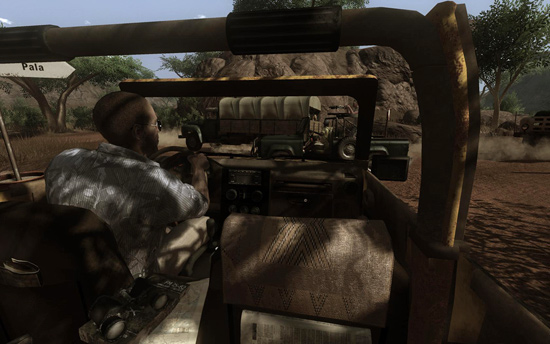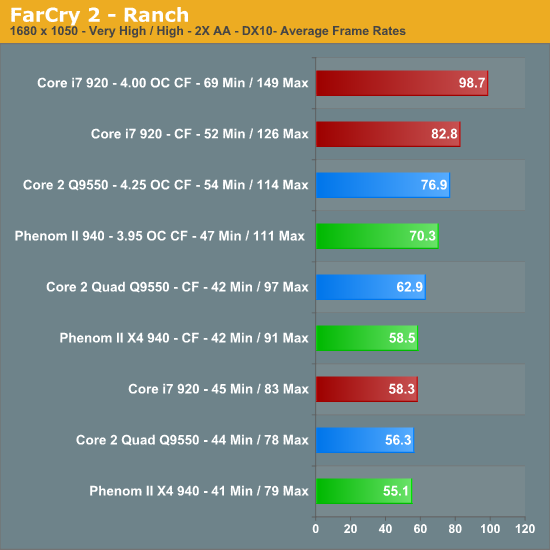CrossFireX and the Phenom II X4 940 – Competitive or Not?
by Gary Key on February 2, 2009 12:00 AM EST- Posted in
- Motherboards
Far Cry 2

This is another highly awaited title from last year that has beautiful graphics, an open ended environment, and is fun to play... but the traveling between missions tends to get repetitive. If you dial up the graphics options, the game rewards with you some fantastic visuals courtesy of the Dunia Engine. The game also features the most impressive benchmark tool we have seen in a PC game. We set the performance feature set to Very High, graphics to High, and enable DX10 with AA set to 2x. The in-game benchmark tool is utilized with the Ranch Small level.

We learned two things about this game. It favors the Intel platforms, and once you provide enough GPU horsepower, the i7 is untouchable. This is especially true once the i7 is overclocked. Although not shown, our single card results with the i7 at 4.00GHz resulted in an average frame rate of 68.8 with the minimum at 54.2 and maximum at 106.2. Single card results with the Q9550 and Phenom II 940 overclocked only increased frame rates by 1fps. If you wanted to pick a single benchmark and show a large disparity in gaming performance between the Intel and AMD platforms, this is the one to use. We would highly suggest to AMD that they send an engineer to UbiSoft for game engine optimizations.
In the 1680x1050 single card tests, the Intel platforms are slightly ahead of the AMD setup; even minimum frame rates favor Intel in this game. Enable CrossFire and we see the Q9550 leading the Phenom II 940 by 7% with minimum frame rates being equal. The i7 CrossFire results are impressive with a 31% frame rate increase over the Q9550 and 41% over the Phenom II 940. Once we overclock our processors, scores improve for the Q9550 and Phenom II 940 with frame rates increasing 22% and 20% over stock CF numbers respectively. The i7 shows a similar 19% increase when overclocked. Even though the Q9550 has a 7% clock speed advantage over the Phenom II 940, frame rates improve by 17% in the overclocked CrossFire results.
Adding a second card for CrossFire operation improves average frame rates by 5% and minimum frame rates less than 1% for the Phenom II. The Intel Q9550 has an improvement of 12% in average frame rates and minimum frame rates actually decrease by 5%. The Core i7 average frame rates improve by 42% and minimum rates increase 15%. Overclocking our processors resulted in an 19%~22% average improvement in average frame rates with the Q9550 benefiting the most.

At 1920x1200, the benchmarks reveal nothing new between the platforms. The Phenom II 940 is competitive with a single card, trails the Q9550 by 8% in CrossFire and 9% when overclocked, even though we start to become CPU/GPU limited on these two platforms. The Q9550 does hold a 17% advantage in minimum frame rates in the overclocked tests. The i7 is just stupid fast compared to our other two platforms with its standard CrossFire results being 8% and 18% faster than the overclocked Q9550 and Phenom II 940 processors respectively. Overclocking the i7 puts it in another league altogether.
Adding a second card for CrossFire operation improves average frame rates by 12% and minimum frame rates decrease by 8% for the Phenom II. The Intel Q9550 has an improvement of 18% in average frame rates and minimum frame rates do not change. The Core i7 average frame rates improve by 53% and minimum rates increase 26%. Overclocking our processors resulted in a 22%~26% average improvement in average frame rates with the Q9550 benefiting the greatest.
When it comes to game play experience and not benchmark tests, all three platforms responded the same at our specified settings. We did not notice any advantages with the improved frame rates that the i7 offers over the other two platforms. However, with the i7 we could change the graphic settings to Very High and increase AA to 4x and still experience very good game play. It was as if nothing changed except now we were looking at the savannahs of Africa in a much better way. These same settings were not always a pleasant experience on the other two platforms during heavy action scenes, but the game remained playable for the most part.










68 Comments
View All Comments
Joe Schmoe - Tuesday, February 3, 2009 - link
This was a very good article. I'm not quite ready to build a new system just yet. But it is tax return season. I'm glad the Phenom II is competitive. We all win when AMD puts out a nice chip. I was about to jump on the I7 band wagon but decided to just grab a q6600 and save my coins for now. Hopefully this will end some of the endless flame wars going on through the forums.
Aquineas - Tuesday, February 3, 2009 - link
First of all, thanks for the hard work you put into testing. Many folks are getting hung up on 5-10 percent performance differences and making a big deal out of it . I think the most important part of the article is the part where it says, repeatedly (paraphrased):"We couldn't perceive a difference in gaming performance between platforms."
That being said, I think 18 months from now we'll see more games where the CPU differential matters more, which is right around the time I'll be doing my next system build.
myterrybear - Tuesday, February 3, 2009 - link
I agree with this as well, great job on the article & shows the point as I have ALWAYS said, when it comes down to it would ya even notice the diffrence between the 2 if you had just sat down on it & started to do stuff on it ??Yeah exactly 6 or 8 gig ram on Phenom II would be interesting, I know I've found 4 gigs on Phenom I to be very nice now that I am running a full 64bit os ( win 7 beta) on a oc to 3 ghz Phenom 9850 be. I'm just awaiting to see how things will be once I get my Phenom II 940 any second now. :)
myterrybear - Tuesday, February 3, 2009 - link
My thing that I am noticing with all these tests of core i7 vs phenom II is the fact the systems are not even ramwise. I mean what would a core i7 run like with 4 gigs of ram or if the phenom II platform had 6 gigs of ram.it's a valid argument I think.
Aquineas - Tuesday, February 3, 2009 - link
Honestly, it probably wouldn't matter much. If I were the author I'd re-run the test with 8GB on the PII, but it's probably less than a 2 percent differential.BlueBlazer - Tuesday, February 3, 2009 - link
Love to see Intel and AMD in SLI numbers!ThePooBurner - Monday, February 2, 2009 - link
Am i the only one that noticed that the results for the PhenomII were just about identical between resolutions? There should have been some form of difference unless the AMD platform is being artificially hard-capped for some reason. Otherwise that the frame rates would be identical when upping the resolution makes no sense at all. I suggest looking into it further.ThePooBurner - Monday, February 2, 2009 - link
Err, Crysis Warhead is what i meant by FarCray2.7Enigma - Tuesday, February 3, 2009 - link
This is a perfect example of why the full data is so incredibly important in teasing out the details.Yes if you look at the graphs they show a very close clustering for the single card, CF, and overclocked CF, but if you look to the right of the names you will see the min and more importantly max will scale with upgraded components. Not to the same level as one would like but there appears to be some really REALLY rough sections as the min frame rate is almost identical across the board (look at single vs. CF you see the same frame rate). That is probably due to some driver issue where both cards are not being utilized and the single card is not optimized well either.
ThePooBurner - Wednesday, February 4, 2009 - link
I think you are missing my point. When going to a higher resolution it is expect that the frame rates for a card will change. Both the min and the max as well as the average. In almost every single game tested the values for the ATi cards at all resolutions are nearly identical. This smells very fishy to me and makes me think there is some sort of artificial limit being placed on the ATi hardware.